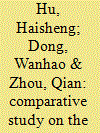|
|
|
Sort Order |
|
|
|
Items / Page
|
|
|
|
|
|
|
| Srl | Item |
| 1 |
ID:
179713


|
|
|
|
|
| Summary/Abstract |
This paper is a comparative study on the effects of a resource tax and a carbon tax. In this paper, we use the computable general equilibrium (CGE) approach to simulate the impact of China's increasing resource tax rate policy and carbon tax policy. The strengths and weaknesses of the two policies are compared from the perspective of energy utilization, air emissions, the macro economy, government tax revenue, household income, and enterprise net profit. A carbon tax leads to a reduction of all kinds of energy consumption. A carbon tax of 1 yuan/ton of CO2 can reduce CO2 emissions by 2100 tons and significantly reduce SO2, NOx, PM2.5, and PM10 emissions. From the perspective of energy utilization, carbon emissions, and pollutant emissions, the effect of a carbon tax is significantly better than that of a resource tax. If the rate of a resource tax rises by 50%, or a carbon tax is levied at the rate of 4 yuan/ton of CO2, China's economy (on a GDP basis) will decline by 0.1%.
|
|
|
|
|
|
|
|
|
|
|
|
|
|
|
|
| 2 |
ID:
177461


|
|
|
| 3 |
ID:
180449


|
|
|
|
|
| Summary/Abstract |
China adopted rigorous lockdowns and restrictions to contain the spread of COVID-19 from 23 January to 8 April 2020. Although the quarantine severely limited people’s freedom and caused multiple secondary disasters, most Chinese citizens tolerated it. Based on an online survey conducted at the beginning of the lockdown (from 31 January to 4 February 2020), we argue that local governments in many parts of the country gained more trust than usual, narrowing the trust gap with the central government. In the early stage of the pandemic, effective implementation of anti-COVID policies, official media propaganda, and public expectation all contributed to the public’s increased confidence in local governments.
|
|
|
|
|
|
|
|
|
|
|
|
|
|
|
|
|
|
|
|
|